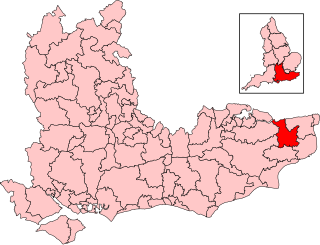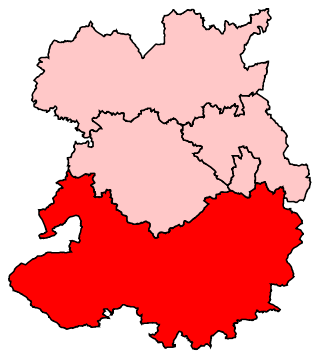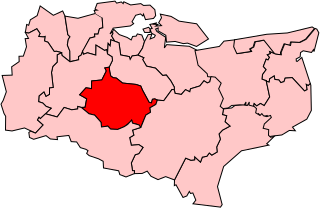Tralee was a constituency in Ireland of the Parliament of the United Kingdom, returning one Member of Parliament (MP). It was an original constituency represented in Parliament when the Union of Great Britain and Ireland took effect on 1 January 1801. The borough constituency continued to be represented until it was disfranchised in 1885.

Canterbury is a constituency in Kent represented in the House of Commons of the UK Parliament since 2017 by Rosie Duffield of the Labour Party.

Great Yarmouth is a constituency represented in the House of Commons of the Parliament of the United Kingdom since the 2024 general election by Rupert Lowe of Reform UK.

City of Durham is a constituency represented in the House of Commons of the UK Parliament since 2019 by Mary Kelly Foy of the Labour Party.

Ludlow was a constituency in Shropshire represented in the House of Commons of the UK Parliament.

Stafford is a constituency represented in the House of Commons of the UK Parliament since 2024 by Leigh Ingham from the Labour Party.

Maidstone was a parliamentary constituency represented in the Parliament of England, Great Britain and from 1801 the House of Commons of the Parliament of the United Kingdom.

Lancaster was a constituency of the House of Commons of the Parliament of England then of the Parliament of Great Britain from 1707 to 1800 and of the Parliament of the United Kingdom from 1801 to 1867, centred on the historic city of Lancaster in north-west England. It was represented by two Members of Parliament until the constituency was disenfranchised for corruption in 1867.
Bewdley was the name of a constituency of the House of Commons of the Parliament of the United Kingdom from 1605 until 1950. Until 1885 it was a parliamentary borough in Worcestershire, represented by one Member of Parliament; the name was then transferred to a county constituency from 1885 until 1950. Its MPs included the former Prime Minister Stanley Baldwin, who represented the seat from 1908 to 1937, and afterwards took the name of the constituency as part of his title when he was raised to the peerage.
Derby is a former United Kingdom Parliamentary constituency. It was a constituency of the House of Commons of the Parliament of England, then of the Parliament of Great Britain from 1707 to 1800 and of the Parliament of the United Kingdom from 1801 to 1950. It was represented by two members of parliament. It was divided into the single-member constituencies of Derby North and Derby South in 1950.

South Shropshire is a county constituency in Shropshire. It was first created in 1832 and was represented by two Knights of the Shire.

Shrewsbury is a parliamentary constituency in England, centred on the town of Shrewsbury in Shropshire. It has been represented in the House of Commons of the Parliament of the United Kingdom since 2024 by Julia Buckley.

Beverley has been the name of a parliamentary constituency in the East Riding of Yorkshire for three periods. From medieval times until 1869 it was a parliamentary borough consisting of a limited electorate of property owners of its early designated borders within the market town of Beverley, which returned (elected) two Members of Parliament to the House of Commons of the English and Welsh-turned-UK Parliament during that period.

Clitheroe was a parliamentary constituency in Lancashire.
Wallingford was a parliamentary constituency in England, represented in the House of Commons of the Parliament of England until 1707, then of the Parliament of Great Britain from 1707 to 1800 and of the Parliament of the United Kingdom from 1801 to 1885.
Cricklade was a parliamentary constituency named after the town of Cricklade in Wiltshire.
Kingston upon Hull, often simply referred to as Hull, was a parliamentary constituency in Yorkshire, electing two members of parliament to the Parliaments of England, Great Britain and House of Commons of the Parliament of the United Kingdom, from 1305 until 1885. Its MPs included the anti-slavery campaigner, William Wilberforce, and the poet Andrew Marvell.
Plymouth was a parliamentary borough in Devon, which elected two members of parliament (MPs) to the House of Commons in 1298 and again from 1442 until 1918, when the borough was merged with the neighbouring Devonport and the combined area divided into three single-member constituencies.
Malmesbury was a parliamentary borough in Wiltshire, which elected two Members of Parliament (MPs) to the House of Commons from 1275 until 1832, and then one member from 1832 until 1885, when the borough was abolished.

William Wolryche-Whitmore, also known as W. W. Whitmore, was a Shropshire landowner and British Whig politician. He held a seat in the House of Commons from 1820 to 1835, representing first Bridgnorth and later Wolverhampton.
This page is based on this
Wikipedia article Text is available under the
CC BY-SA 4.0 license; additional terms may apply.
Images, videos and audio are available under their respective licenses.











